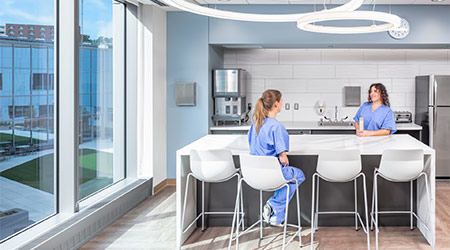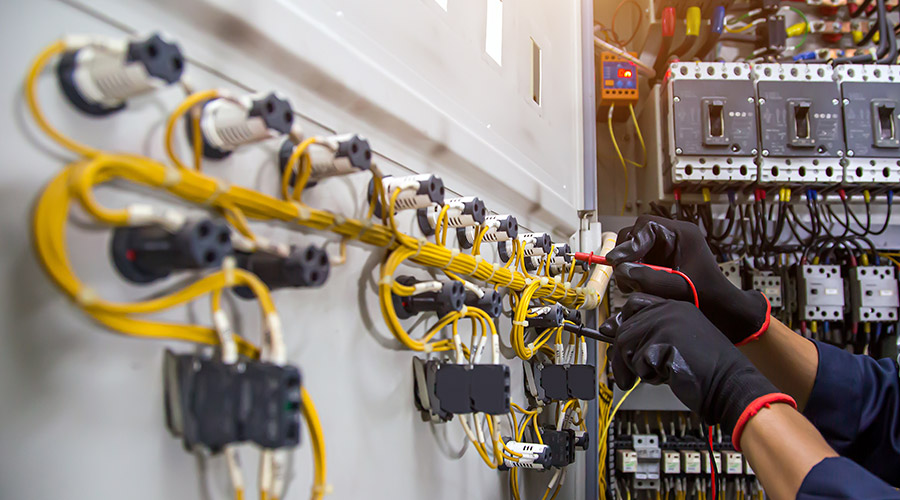Patient experience has long been discussed at the forefront of healthcare projects and for valid reason. Facilities providing a perceived positive experience for their patients receive higher HCAHPS scores, one measure in an organization’s Medicare/Medicaid funding levels.
However, the value of providing an equally positive experience for staff should not be underestimated. A Press Ganey national comparison data study in 2017 found that increases in both employee engagement scores along with patient ratings of communications with nurses correlated to increases in both hospital ratings and net operating profit margins. Conversely, rates of depression and burnout among medical professionals have a direct impact to patient care as well as staff morale and staffing costs.
COVID-19 has made that exponentially clearer. A report from The New York Times early into the pandemic spotlighted the physical and emotional toll that frontline healthcare workers face on a day-to-day basis and how the pandemic exasperated the problem. It heightened already concerning levels of burnout and stress, and is leading to an increased number of individuals wrestling with grief and even PTSD.
“That ‘bank’ of engagement and goodwill is now significantly drawn down, with the emotional exhaustion caused by multiple major public crises making workforce burnout far more prevalent and serious,” says Steven Berkow, vice president of the Advisory Board.
These were all real factors pre-pandemic. Now when staff trauma and stress is real-time and at levels many have never experienced, there is a need for greater focus on fostering a resilient healthcare workforce, both to retain those already providing the care and recruit those who will be needed to continue the care. Supporting that resiliency takes an environment that promotes resiliency.
Small changes, big impacts
While there are undoubtedly operational improvements that can be made to contribute to a positive work environment for healthcare workers, there are opportunities through space and design to create positive change as well. Previous strategies to support staff often took the form of a well-designed breakroom, and while those strategies have evolved through the past decade or two with more welcoming and comforting cafeterias and commons areas that have better options, it still relied on a capital expenditure and real estate allocation. As our knowledge of employee health and wellness and their connection to work effectiveness and satisfaction has grown, we understand how small changes to existing staff-dedicated spaces significantly impacts physical and mental wellbeing.
The WELL Building Standard launched in 2014 expanded the knowledge on what components of a built space influence people. Going beyond physical attributes, the standard spotlights elements that encourage and support communication, camaraderie, and rejuvenation. It’s about caring for those who provide care. Making a few of the changes to any physical space already dedicated to staff offers an opportunity for major positive impact on resilience of those individuals. These spaces should provide respite, a place to mentally and physically disconnect from everything else.
Nature is one strategy to induce positive change in staff environments. More than two decades of studies continually show that incorporating nature, real or implied, has a proven healing effect on individuals, hence why it is a common theme and concept used in the design of patient and public spaces. In a 2018 study, “How does nature exposure make people healthier?: Evidence for the role of impulsivity and expanded space perception,” researchers found nature accessibility and exposure reduce reported depression, anxiety, and stress while improving general health and wellbeing.
Nature-based art on the walls can both create positive distractions and provide the healing benefit of experiencing a form of the outdoors. Scenes such as a flowing creek or clouds passing through the sky grant a sense of calm and can help transform a static break room into a relaxing respite space for staff to disconnect and recharge. Incorporating a variety of real or artificial plants, or even using an existing monitor to cycle through still images of nature, also can achieve the goal.
The benefit of control
Allowing staff control over their environments via sound and lighting options offer further opportunities to create a space for relief and positive distraction and are relatively easy to incorporate into existing space. A sense of control is especially important when people are in a seemingly uncontrollable situation, whether that is work-related like patient surges or mandatory overtime to something that is more environmental such as seasonal affective disorder. Beginning with sound, a noise machine or a wireless speaker provides background noise or music as a way to disconnect. It also offers individuals the opportunity to create a tranquil environment for focused meditation, prayer, or to just be in their thoughts.
Providing a variety of lighting levels also allows the space to flex more actively or create a deeper sense of calm. Table or floor lamps throughout the space not only allow staff control over their environment but also provides a more welcoming, home living room-type of setting. A small sensory space with adjustable lighting goes further to offer staff a place to focus their attention on healing. Long incorporated into patient space design, these examples provide similar benefits to staff with places for mental and physical healing,
Beyond sound and lighting, technology expands the options through which staff can find a physical or mental escape from daily stresses. A monitor in a break room or dedicated staff space, if there isn’t one currently, can provide numerous beneficial resources, from on-demand programming such as quick yoga sessions to guided relaxation/meditation or one-on-one counseling for emotional support. Monitors also can boost morale with displayed messages of acknowledgment and gratitude both from the community and leadership, helping staff feel supported, valued, and appreciated for the work that they perform every day.
Encouraging staff to seek help for themselves by providing easily accessible, convenient access is key.
“It’s not a bad thing,” says Ellen Fink-Samnick MSW, ACSW, LCSW, CCM, CRP, DBH(s) to HealthLeaders. “This is why there are so many wonderful resources out there being built on virtual platforms strictly for professionals. If we can’t attend to our own human condition, we are useless to care for the human condition of others. Healthcare staff can tend to think of themselves as the ones that provide help, but this should not deter them from asking for it when they are the ones in need.
Supporting staff mental health needs goes further, enabling them to access the family and friends support structure so vital to their health. Since not everyone goes home after a shift for a variety of factors, due to circumstances like proximity to work or concerns of spreading the virus, dedicating space to staff for those important, meaningful connections and conversations is critical. Spatial dividers, a few high-backed seating options, or even positioning the furniture within the room differently can turn an otherwise open, shared, active space into a more intimate one conducive for personal calls or video chats. When those types of arrangements are not needed, the space can easily flex back into a typical shared breakroom space, promoting collaboration and camaraderie among workers.
COVID-19 has spotlighted the value that appreciation and gratitude has on the psyche of frontline care providers. The pandemic also has revealed how the unrelenting stress and demands can overwhelm both the body and mind of staff who are so focused on the care of others that they may overlook their own needs. Communication has always been a key strategy to building morale within an organization, but as we’ve learned over the past decades, the physical and technological structures organizations put in place to support the physical and mental health needs of its staff can communicate something greater — that their staff’s experience is as important to the care of patients as the patients’ experience itself.
Devan Swiontkowski, Assoc. AIA, EDAC, is a project planner at BWBR who graduated from University of Kansas with both a master’s degree in architecture and a certificate in architecture of health and wellness. Dani Ostertag is a senior interior designer who holds a bachelor’s degree in fine arts-interior design from University of Wisconsin-Stout.

 All Eyes on Gen Z as They Enter the Workforce
All Eyes on Gen Z as They Enter the Workforce Cleveland Clinic Starts Fundraising Effort for New Hospital in West Palm Beach
Cleveland Clinic Starts Fundraising Effort for New Hospital in West Palm Beach Cultivating a Workforce in the Face of Skilled Trade Shortages
Cultivating a Workforce in the Face of Skilled Trade Shortages Prime Healthcare Acquires 8 Ascension Hospitals in Illinois
Prime Healthcare Acquires 8 Ascension Hospitals in Illinois Charging Ahead: Incentives Driving EV Charging in Healthcare Facilities
Charging Ahead: Incentives Driving EV Charging in Healthcare Facilities